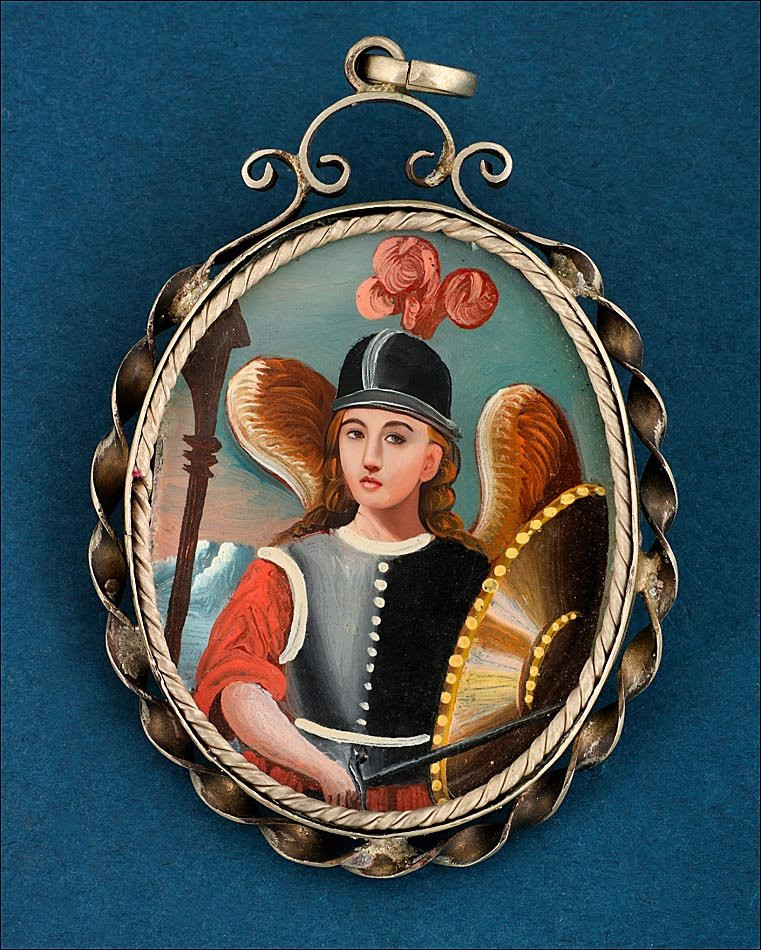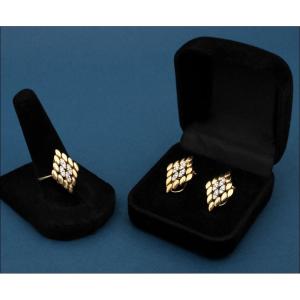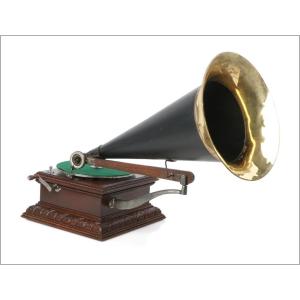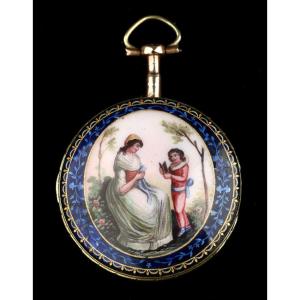The image depicts Saint Michael the Archangel in his classic role as celestial warrior, dressed in Roman-inspired armor, with winged helmet, golden shield and raised sword, as he triumphantly subdues the devil —faithful to Christian iconography. His spread wings, idealized background and frontal composition reflect a visual language deeply rooted in the Andean tradition, heir to the colonial baroque, yet interpreted with a popular and devotional sensibility.
Stylistic elements such as bright colors, strong outlines, lack of academic perspective and symbolic composition are hallmarks of the late Cusco School, which remained active well into the 19th century. These works were typically produced by family workshops that continued to supply local devotional needs. While a Bolivian (Potosí) origin is a remote possibility, its characteristics strongly suggest a Cusco-based production.
The pendant’s frame, fully intact and beautifully preserved, is handcrafted silver, with twisted borders and elegant volutes on top. Likely intended for personal wear or use as a reliquary, it exemplifies the integration of art and private devotion in the Andean world. The painted image is in excellent condition —with no visible losses or cracks— making this a highly valuable artifact from the post-colonial period.
A unique devotional object, rich in symbolism and visual harmony, ideal to be reintroduced in the Church and used in a parish. A true collector’s item for those interested in South American religious art or Andean cultural heritage.
Measurements: Painted image: 4.6 cm (1.8 in) - 3.6 cm (1.4 in).
History of Saint Michael the Archangel in Cusco Art
Saint Michael the Archangel was one of the most widely venerated figures in the colonial Andean world, especially in Cusco, the heart of the former Viceroyalty of Peru. From the 17th century onward, his image appeared in churches, convents and homes, symbolizing spiritual defense and divine justice. In Cusqueño iconography, Saint Michael adopted distinctive traits: ornate armor, elaborate shields, solemn posture, and often local elements such as Andean flora, skies, or landscape features.
Throughout the 18th and into the 19th century, Cusco workshops continued this tradition, producing images of Saint Michael in many formats, from large altar paintings to small metal retables and devotional medallions. These miniature works, like the pendant here presented, preserved the emotional intensity and symbolic power of the baroque tradition, reinterpreted through the lens of popular devotion.
In this context, Saint Michael was not only a spiritual protector but a symbol of cosmic order and divine intervention. His image was kept in homes to ward off evil and ensure harmony. In the Andes, and especially in Peru, Saint Michael continues to be venerated today in processions, folk dances, and religious festivals, as a timeless icon of divine justice and celestial strength.


































 Le Magazine de PROANTIC
Le Magazine de PROANTIC TRÉSORS Magazine
TRÉSORS Magazine Rivista Artiquariato
Rivista Artiquariato